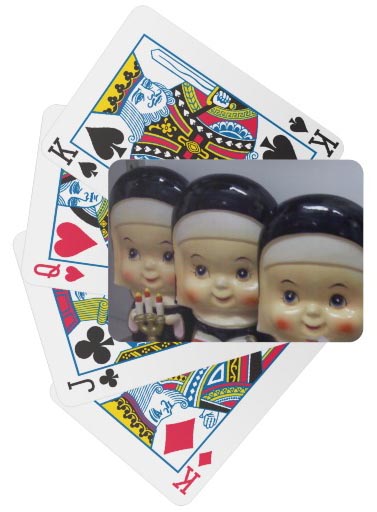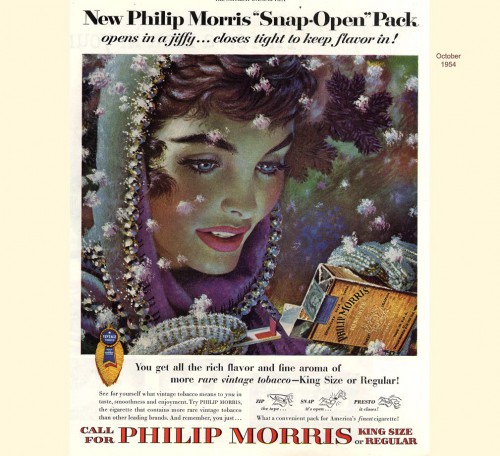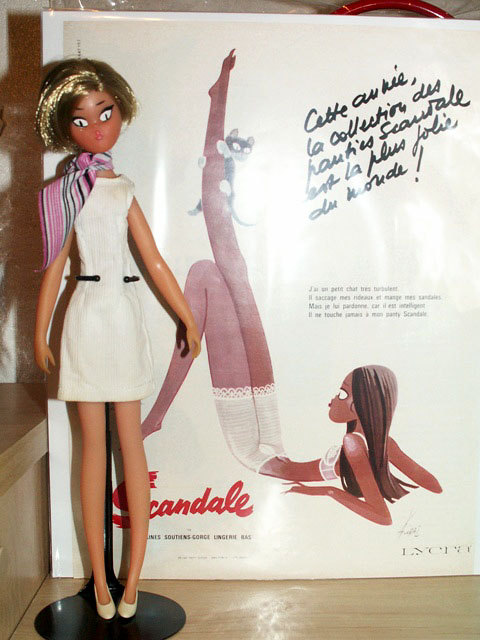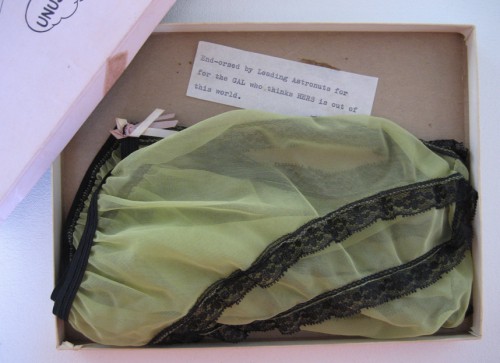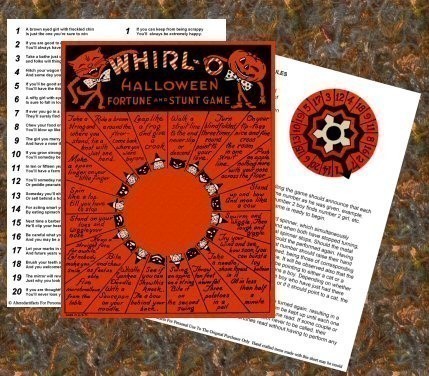From hubby’s blog, here’s one of the images of Carol R. Dettmann as “Katy High,” promoting TV station KTHI and the station’s record-setting construction project in North Dakota. At six-foot-one, Carol Dettmann was Miss Tall Milwaukee and possibly Miss Tall International in 1963…
The Early History of Women & Film
 In Movie-Struck Girls: Women & Motion Picture Culture After the Nickelodeon, by Shelley Stamp, we learn more than just the roles of women in films or behind the camera — we learn about women’s role as patrons of cinema.
In Movie-Struck Girls: Women & Motion Picture Culture After the Nickelodeon, by Shelley Stamp, we learn more than just the roles of women in films or behind the camera — we learn about women’s role as patrons of cinema.
The book is an eye-opening look at a long ignored part of American film history — and an astonishing look at the history of women as media consumers.
Stamp spent over ten years researching for this book. She studied trade journals, fan magazines, ephemera, and many official documents and records at the National Board of Censorship Archives in New York City, the Academy of Motion Picture Arts and Sciences’ Margaret Herrick Library in Los Angeles, & the New York Public Library for the Performing Arts. Many of the films she reviewed are no longer readily available, let alone circulating, but can be found at the Library of Congress & the UCLA Film and Television Archive.
It sounds like a huge undertaking, & I thank her for it. ‘Movie-Struck Girls’ presents a wealth of information that I had never known before.
Movies began with the nickelodeon, and as such, movies were not places for proper or even improper ladies to be. In the early 1900s, when films were being moved from temporary places with projection onto sheets & walls, and cinemas were being built, many in the business of film, began to reconsider women. This was a purely economic move. For if these new developments, these more expensive buildings, were going to pay for themselves & gain profits to pad pockets, the new movies must include women as patrons & gain their approval.
Why? In ‘Movie-Struck Girls’ the author reminds us of an America where women were seen as the keeper of the family morals. Neither little Johnny Jr. nor Johnny Sr. would be allowed to go to such places if Mother didn’t approve. In order for women to view movies as more than sordid places where her family wouldn’t be caught dead, these new cinemas would need to gain the respect of women. The best way to do that, would be to show women, fine respectable women, how respectable & fine the theaters were. It was thought that if women would give the theaters a try, and continue to come, their physical presence would elevate the standing of film viewing.
So, movie theater owners began to court women as patrons.
They did so via premiums & tie-ins & in addressing the decor of the cinemas themselves. As a marketing person, I enjoyed the conceptions about women, and how they would lure them into the movie-going fold — with many of the tricks still employed in the movie trade today. As a woman, I felt more than a bit bitter to see what they thought…
As Stamp illustrates, cinemas were designed with appeal to women in mind. They were located near shopping and offered services such as package holding with hopes of luring women into the buildings. The buildings themselves were decorated to attract the feminine. It was suggested in industry publications that cinemas ought to have lobbies, with plenty of mirrors, to encourage female patrons — by appealing to their vanity. They thought ‘what woman doesn’t want to see herself & parade for others?’
But then, they complained that women didn’t know how to behave properly: they talked, they interrupted the absorption of the movies themselves. The very women they encourage to be vain, to come to the theater to be seen, these women didn’t want to sit quietly in a dark room full of others who were not paying attention to them. These women who were, by societal standing, to ‘dress’ for these public events, they wore hats that blocked views. And so even while courted by the film industry as valuable assets to ensure the viability of films as safe, moral entertainment for families, the industry mocked them in articles & cartoons. The debate within the industry as to the need for women, how to both cater to while educating them to achieve their purpose, was entering full swing.
But this was only the industry side of the debate; Next, Stamp shows us society’s debates.
In the early 1900’s, the most popular films were vice films, & in the teens, a major societal concern was The White Slave Trade. Sensational white slave films were made during this time, to warn folks of the dangers to their women. Conflicting with the as-billed-educational-films messages, cinemas brought women-folk out into public where they could easily fall prey to such ills as the white slave trade. Debate centered around the irony. Other debate focused on the films themselves, and censorship issues were raised. And to make matters worse, women seemed to enjoy such films! Oh, how could such tender beings watch & enjoy such lewd filth such as scenes from brothels?!
Obviously, women enjoyed the films from the same points of fascination as men, but as the author clearly reminds us, there is more. Adding to the fascination, was the fact that women themselves has seen little of ‘the world’ — even if that ‘world’ was part of their very own city. Through movies, women vicariously saw their nation. This alone would make these films riveting for women.
Again, as movie houses were public gathering places, classes mingled. Not only were there the fine upscale families as so recruited by theater managers, but along with them, the working class — including single women. Single women moved about the theater as patrons, both in danger & dangerous themselves. A woman alone could end up in the slave trade, or she might mingle with gentlemen of good standing… In fact, theaters often hired pretty, single young girls to be ticket sellers, ushers, cigarette girls etc. This was seemingly at odds with the motives of ‘women adding respectability’ and elevating the idea of theater, but it was a lure that worked. But the independent woman, even if only a work-class-girl, is dangerous. Much debate centered around the appropriateness of such places for women & families.
Since the elevation of cinema depended upon the stamp of approval from women, including materials & promotions designed to engage them, the talks about women’s roles in film viewing were discussed by women. Given the general fear of ‘those darn suffragettes,’ encouraging women to debate the social & safety issues of women viewing film — in the context of women viewing educational films about civil matters — seemed a dangerous thing indeed.
The film industry needed to ‘clean up’ the entertainment, so they began to focus on films aimed at women, with stories & formats they knew — Enter the serial film.
The industry coordinated film with print versions of stories in newspaper & print publications. Again, these were often aimed at women, but then came the ‘oh no!’ cry, as women did in fact enjoy the adventure stories. It is at this time that film gave rise to the very popular female star. She was now revered for both her on-screen & off-screen antics. So much so, that young women everywhere started dreaming of being a movie star themselves!
To counter act the scary notion of independent women, adventure serials, & vice films it became routine to mock independent women, with notions of becoming a movie star, or worse, civic ideas. The author clearly shows examples, such as a 1916, The Motion Picture Classic cartoon with the following poem to illustrate this concern:
“When our dear grandmas were girls,
They’d smile and smooth their pretty curls.
Look in the mirror then & say
“Oh, will he think me fair today?”Today the girlies everywhere,
In the mirror gravely stare;
“Am I fair enough,” they day,
“To be a movie star some day?”
But poetry would not be deemed enough. There would also be many films to lampoon the suffragette.
Mainly these films attempted to show how crazy things would be if women could vote. Movies depicting women taking over government & leaving men’s needs behind darkly illustrating the dangers present to men were made, but more often, comedy was used. Cross-dressing men & women exchanged roles, with only love ‘saving’ the women from their folly. Ironically, it seems to the reader that perhaps these movies did more favor to the opposition than to their own cause.
The suffragist movement noted the power of cinema. If educational films were popular, and women not only allowed but encouraged to attend, why not make propaganda films of their own? Both the National American Woman Suffrage Association (NAWSA) & the Women’s Political Union (WPU) made films to both rally women to the cause & to educate resistant men & women. Sadly, many of their films seemed to falter at romantic notions. In order to make the female stars appealing, less threatening, most often the female lead would succumb to love & home, happy with her vote, but definitely not claiming civic responsibilities.
In ‘Movie-Struck Girls’ you learn all about these long-hidden details of American film history & it’s collision with turn of the century American values — including titles, studios, stars, organizations, & political figures. For a person who adore film & is a passionate feminist, this is a great read. Why it’s as thrilling as those old adventure serial films!
Stamp does a great job of presenting this long ignored part of film — and women’s — history. It’s definitely an academic read, which means it is meaty enough for those who want to further search for clues, artifacts & films themselves. It may not read like a novel, but it’s so fascinating & full of details, it won’t disappoint. Fans of film, especially silent films, cannot call themselves educated in the subject unless they know this history. And women, well, we start to see a much larger image emerge — our complaints regarding women in the media have much deeper roots than we previously knew.
Pray For Luck Poker Cards
I just uploaded these kitschy retro nuns on playing cards to the Zazzle shop I run with friends. Today’s the last day to save 50% with code MAGICALSALES at checkout.
Combining Your Love Of Ephemera With Strip Tease…
He Is The Most Self-Deprecating Man In The Room
Any man who brags about his speed in bed takes a chance. In this case, humor disarms as well as charms. I’d give him the minute or two. *wink*
http://youtu.be/GPhjyc3bgmw
Meanwhile, in other Virgin Mobile news…
Antique Chastity Charm
As a feminist and collector of women’s history, I am completely head-over-heels in love with this old sterling silver chastity charm featuring panties and a lock. No key, of course. *wink*
Things Are Different In Scandinavia
For example, you can show female nipples on your coffee mugs< — even in front of the children.
The Blossom & Bill mugs in porcelain come with a funny and harmonic design for both children and adults. The mugs are included in the Blossom & Bill series witch also includes trays, notebooks, and kitchen towels and together they make a perfect set.
Child protective services would be called into US homes where Blossom & Bill readily appear. By ISAK.
Antique Sexist Postcard
Cheap Thrills Thursday: For The Girl Who Has Everything – Except Decent Friends
Niftees Nipple Warmers For The Girl Who Has Everything, made by USA Novelty, 1974. Baby, you think it’s cold outside? Wait ’til you see how frigid it gets when you give this gift. (Ugh. I have now just ruined that song — all versions — for myself.)
Thank heavens the “quarter for size comparison” trick was only used by the seller near the closed box!
Dancing At The Mall
Barefoot dancers performing in front of the Thom McAn store. Via.
Ready To Climb The Corporate Ladder
She’s dressed for that sort of success. Via.
Taking Photos At A 1950s Beauty Contest.
Every (heterosexual) man is thinking, “Sweet gig!”
Every woman is thinking, “Push him in that pool!”
Desperate To Be Obscene
EBay seller LadiesOnFilm carries a large number of vintage risque and nude images from publishers of adult magazines from the 60’s through the 90’s. It’s rather clear that many of them are the unused outtakes; but then, I guess “outtakes” are in the mind of the viewer.
It’s funny how often the “bad” pictures seem more natural than the “good” pictures. I find this photo of Carol Newell (by Ron Vogel, 1968) charming. It’s how a woman sits on the stairs, relaxed, not worrying about the planes of her face and the contours of her body… There’s no arching of her back while pointing her toes. That’s how the real girl next door sits.
The women struggle to look natural in odd poses. While the props are often dated and hysterical, it’s the desperate poses for the sake of sexual puns which are far funnier. I can just hear the photographer saying, “That’s it, that’s it, baby. Now just crawl along the floor and choke that plaster snake statue…”
I’m not saying that no simply nude woman has ever taken a bad photo, but they are far more beautiful than those photographs which overreach — either in physicality or in attempts at innuendo.
Cheap Thrills Thursday: Smoking Beauties
Vintage Philip Morris ads (featuring “vintage tobacco”) with pretty illustrations by Edwin Georgi. These are so beautiful, I wish they had made a series of prints like they did with the American Beauties girls, the Northern Paper Mills aka Northern Tissue ads illustrated by Frances Hooks.
What To Wear Under Your “Mom Jeans”
I don’t agree with Oprah about many things; among them her attitudes about domestic violence (which Alessia articulates so well) and “mom jeans.” So while I was not thrilled only to have copies of People Magazine to flip through while in a waiting room recently, I was thrilled to see female celebrities rocking the “mom jeans.”
“Mom jeans,” you may or may not know, are jeans that go up to your waist and, so, actually fit. Some of us have to go out of our way to find these jeans — but if People is any indication, soon we will have them back in ready supply.
No matter what Oprah and others might say, pants that fit your curves, rather than being slung around and beneath them, are sexy. Just not having your unmentionables (or actual body) on display and ready to be discussed is a comfort that adds confidence; am I right, ladies? In fact, one of the best things about these “high-waisted” jeans, is the inability to spot whale-tails. And this also means the so-called mom jeans allow a woman to wear underwear that fits.
With mom jeans, you can wear panties which cover your entire bottom as well as go up to your waist. You might call them “grannie panties,” but in lingerie fashion terms these vintage styled panties are called “full-cut” or “full-coverage” panties and they make visible panty lines (VPL) things of the past.
And these vintage-styled panties can be completely sexy. They can feel sexy and look sexy. Like these ultra sheer panties from Secrets In Lace.
The combination of modest in public “mom jeans” and skimpy in private “grannie panties” quite suits the way I prefer to live my life.
The Retro Sheer Panties are made of 100% nylon, come in five colors (Beige, Black, Pink, Red, White) and seven sizes (S,M,L,XL,2X,3X,4X) — and they are only $11.99.
Secrets In Lace also makes other full-cut panties, including sheer ruffled and embroidered varieties, as well as slinky satin ones. Go ahead, get your sexy grannie panties on. And your mom jeans. If you can find them.
How Masculine Or Feminine Are You?
I Dreamed I Took A Bull By The Horns
And awoke to find it was merely a Maidenform ad from March 1962. I hope this isn’t a political premonition of futile efforts for women’s rights.
The Cost Of Rape
Below is an image purported to be an actual statement showing the monetary cost of treatment a rape victim receives at a hospital in the United States. While the estimate, or average, financial cost for surviving rape victims vary, especially if the crime is far more violent, the shocking truth is that rape costs victims — all rape victims, be they straight or gay, in urban settings or on reservations, etc. — financially as well as physically and emotionally. This bill doesn’t even show the lost income from missing work, the cost of a new door lock, counseling, etc. This is one reason why the federal Victims of Crime Act (VOCA) and the Violence Against Women Act (VAWA), imperfect as they may be, are so important.
A Reminder About Our Rights: We May Have Won, But…
While we sane folks may be celebrating the re-election of President Obama and the slew of other positive election results, we can’t forget that the battle continues. These insane control-freaks still exist, many still have power. And many nutballs weren’t up for election and remain in office. This is especially true of what Rachel Maddow correctly calls the “creepy rape and abortion caucus”. They, and their misogynist myth-information still exists. We must continue to fight to keep our rights — and in many cases, where rights and access was stripped from us, to get them back.
Image via Nerve.
Drooling Over The Secretary In The Tight Orange Dress
“Thought you said this drink would knock my hat off!”
But instead she lost her panties. (Insert bawdy laughter and snickers here.) A vintage naughty novelty chalkware ashtray which, if money were no object, would be added to my collections (both the “women’s” collection and my chalkware collection. Signed and dated copyright 1952, J H Fuller. Available for sale here.
Strong Enough To Submit To A Man
Daniel writes in with a comment regarding the 50 Shades of American Women magazine and the whole 50 Shades of Grey phenomenon:
I’ll confess that as a feminist, I’ve had a rough time accepting my submissive streak. I purchased that magazine — but speaking loudly about “what a joke it must be” to friends, rather than letting on how the idea turns me on. I may have accepted this side of my sexual personality, but that doesn’t mean I have to share it with anyone other than my lover!
The magazine wasn’t very good, but thanks to articles like yours I’m feeling ready to go from erotic fantasy in my mind to sexual adventure in the bedroom. I’ve laid the ground-work with my man, talking about it, and I’m pretty sure we’re both willing… Looking forward to it, even. So the question is, how do we go from talking the talk to walking the walk? And I’ve been reading that some men find it to be a fantasy killer for the submissive woman to take the lead on — they find it to be too much pressure to perform. So where do I begin?
Congrats, Daniel, on accepting who you are and for not letting the political negatively impact your personal life. Liberty and equality pertain to the bedroom as well as the boardroom or any other sphere the world thinks we should limit women’s rights to.
While this isn’t my area of expertease *wink* here’s what I say about trying anything new in general: Keep an open mind — and a sense of humor. That means, if you feel the need to nervously giggle, let the laughter out. Both of you. It won’t ruin the mood in the long run. In fact, laughter helps alleviate the tension so you can move past it and on to other things.
 Practically speaking, the first step is to any sexual role play is to get a prop, toy, or costume piece. It will help to set the tone, give you something to work with, even when you have a giggle fit.
Practically speaking, the first step is to any sexual role play is to get a prop, toy, or costume piece. It will help to set the tone, give you something to work with, even when you have a giggle fit.
When it comes to bondage gear, go for something simple that isn’t too intimidating for you or your partner. You can always add things as you and your role play progresses.
And don’t forget the lube. Anxiety and even a bit of fear can literally provide physical resistance, and lube will help you slide into things just fine.
So You Want To Sell Your Books (Almost Everything You Need To Know)
 So you’ve decided to get rid of your books… Sometimes it’s just a matter of making some empty space on the bookshelves; sometimes you want to fill the empty space in your wallet or checking account. If you are realistic, you can achieve a bit of both at the same time — if you aren’t on some sort of quick deadline.
So you’ve decided to get rid of your books… Sometimes it’s just a matter of making some empty space on the bookshelves; sometimes you want to fill the empty space in your wallet or checking account. If you are realistic, you can achieve a bit of both at the same time — if you aren’t on some sort of quick deadline.
The first thing to decide or know is your goal.
Are you trying to make money? Is the money just to be used to support your reading habit (to buy more books) or to become a bookseller (and make a full or part-time income)? Are you just trying de-clutter your living space? Do you need to divest yourself of your books in a short time-frame?
In a hurry?
If time is a constraint, say you need to get rid of a lot of books before you move in a few weeks, there’s always your local used bookstore. They may not pay you much for the books, but, if they take all your books, you will get your space back.
You can also donate used books. Along with thrift stores, there are many other places to donate books, many of which will allow you to take a tax deduction for them. Hospitals, women’s and children’s shelters, nursing homes, groups that work with the homeless — many charities take books. Prisons even take books. Generally speaking, anything with “adult” themes (i.e. erotic fiction, and, sadly, in many cases, books on human sexuality) should be pruned from your collection prior to donation.
If you have the time and transportation, you can do a combination: take your boxes into the used bookstores, have them pick what they want to pay for, and then donate the remainders.
Not in a hurry or just a reader with a few books to get rid of?
Readers may be more interested in swapping books. There may be local groups in your area; you can check sites like FreeCycle to find them. And you can also use online sites such as BookMooch, PaperbackSwap, and even BookCrossing.
So you’ve decided to sell your books…
Next, you have to decide what kind of books you have (simply used books or more valuable works) and then determine which is the best place to put them in front of the appropriate bibliophiles (readers, collectors) — while keeping in mind how quickly you need them to sell.
Some sites, like eBay, which offer the auction format, are designed to have quicker sales. Other sites, like Amazon, Abe, Etsy, and eBay stores, allow books to be listed for longer time periods. Some sites, like Abe and Alibris, are known for specializing in books.
Along with online marketplaces, there’s also creating your own site. PayPal buttons offer easy purchasing. Blogging software, like WordPress, now offers ecommerce plugins. These options require you to drive your own traffic to get sales; but the rewards can be greater in terms of control and profits.
Are your books worth anything?
That depends.
When it comes to the sale of anything, the value the item has is determined by the marketplace. Simply put, the buyer buys at the price he wants to pay; a wise seller knows what is fair to ask. Three general rules on book values are:
1) The newer and more popular a book is, the less value it has. Just try to make money of a mass market Twilight paperback; they are everywhere and have little value right now.
2) Older books value lies in having a popular interest (a larger number of people looking to buy it) and in being rare. Yesteryear’s Twilight sensations may still have no value because so many copies were printed and sold — and still can be found. But, with vampires, horror, and the occult still being a popular interest, older books in these areas may be worth quite a bit, providing the book is still a good story and/or is a rare find.
3) Condition is always an issue. The less legible, intact, or as originally issued (dustjackets, etc.), the less value the book has.
It’s important to research your books in terms of prices as well. Using BookFinder can help you find an idea of what a book may be worth. I say “may be worth” because you’re going to get not only a wide array of varying book conditions (which will affect price) but the prices you’ll see listed are asking prices. Who knows how long those books will sit there for sale at those prices, if they will even sell? FadedGiant helps book sellers by providing a database of prices realized (prices sold for) in antique, vintage, and collectible books. It’s important to note that the FadedGiant service is limited. It does not have every old book in the database. Their sold listings will not tell you anything about the condition of the books. And any prices realized will be but a snapshot of what the books was worth at that time. But FadedGiant and BookFinder are great ways for the novice to get an idea of price range; what titles, authors, and attributes are most desirable; and where different sorts of books are being sold. Many professional booksellers use a combination of sales outlets, real world and online, to maximize profits selling their books.
Multiply this work by the number of titles you have, and you can see how the time adds up!
What costs are there?
Seller fees. Each online sales marketplace has a fee structure. There are fees for listing items, fees for when items sell, and sites like PayPal, merchant accounts, etc. have fees for handling the sales transactions. Depending upon which sales platform(s) you use, you’ll have a mix of these costs. Knowing them upfront means you can more accurately set your book prices so that you profit from the sale after fees are taken out or paid.
Shipping costs. Shipping costs include boxes and mailers, packing tape, shipping labels (the ink and paper you print them on), and other items for packaging. There’s also fees for shipping insurance and tracking options which many sellers must use to protect themselves during sales transactions. If you don’t properly calculate and charge for those shipping costs, it can really eat at any profits you may have.
So can the time it takes to ship items. A lot of sites won’t let you add-on a handling fee to your sale, but let me tell you, if you list a lot of books it can take hours from your week or even your day to pack and ship the books you sell.
Additional time factor costs. Along with the time invested in research, there’s time listing your item. You’ll want to not only to give all the usual information (title, author, publication date, etc.), but you’ll want to mention any interesting features (is it illustrated, signed by the author, a first edition, etc.) and you’ll need to describe the book’s condition (is it written in, is the binding sound, etc.). Per the site’s rules, you may need to photograph or scan at least the cover. Sometimes, when you list an item online you’ll have a lot of questions to respond to from potential buyers or interested bidders. And then there’s the time spent organizing your books for sale. (You have to be able to find a title quickly to answer questions and to ship it.) This time can add up surprisingly fast.
If, after all this, you find you are only getting a dollar or something for your book, it may not be worth your time to sell books online.
What else do I need to know?
Seller feedback and rating systems. When you are new to selling online, it takes awhile and to build feedback ratings. Generally speaking, the more valuable the books you have to offer, the more important the feedback etc. is going to be to potential buyers. Often, a new seller will start out selling some of their items at lower prices just to start earning good ratings from buyers. It can also help to be a buyer at the site as well, as that will help build positive feedback for you as a member.
Promotions. Most successful sellers online now promote their listings, stores, and websites via blogs, social media, etc. Traffic online is like traffic in a store; the more people who stop by to see what you have, the more likely you are to have sales. But learning how to effectively market yourself and promote your goods online is a whole other set of skills — and, for many, another learning curve.
Other options:
If you don’t feel you have the feedback (or the time to generate the feedback), if you feel this is too much to learn, or if selling your books is just a one-time event you don’t feel is worthy of investing so much time in, there are other options.
There are people and companies willing to sell for you, such as eBay consignment shops. And there are dealers and others who may buy books directly from you.
You can post your offerings on places like Craigslist; walk your books into antique shops, used book stores, etc.; or sell to book dealers and those who manage estate sales. If you have a large number of books to sell, and they are not overly rare or otherwise valuable, this most likely will mean selling to local dealers in your area. But there are dealers, estate agents, and even auction houses which will make long-distance deals as well, provided your books are worth either party paying for the shipping costs.
Remember, dealers, used bookstores, antique shops, and the like are only going to pay you wholesale prices for your books. “Wholesale” means at a lower price than what the books will eventually sell or retail for to buyers and collectors. That means you will not get the top dollar from book dealers and other such folks. That’s only fair; look at all the work they are doing to get it! Plus, you’ll have cash in hand, while they will be waiting for the books to sell to get their share.
I Bet You Think I’ll Hate This
But I actually quite like this vintage Scandale lingerie advertisement with artwork by Edmond Kiraz.
Impossibly long legs don’t bother me — when they are part of fashion illustration. As Slip of a Girl writes, “Illustrated ads do not run the risk of starting or perpetuating body dysmorphia or forms of self-hating body loathing because we know they are illustrations — no one looks like that. But we can pretend to…”
The female depicted as feline, while cliche, isn’t a real bother either; women have relationships with cats, like it or not.
But perhaps the best thing about this vintage ad is what I learned: Kiraz made dolls. Fashion dolls based on the artist’s Les Parisiennes series, to be precise. What Kiraz himself calls the “effigies of his work made by Birgé-Jopo”.
Often called Poupee de Kiraz or Les Parisiennes dolls by Kiraz, these 15 inch tall French fashion dolls seem to have only been made for one year, in 1967. That makes these little gems difficult to find. And playing hard-to-get does so turn me on as a collector. I am now on the look-out for these vintage vinyl fashion dolls from France. The ones with the round faces, cat’s eyes, and impossibly long and slim legs. So period. So fascinating.
All images via GGSDolls.
Boil, Toil & Trouble: What You Don’t Know About Women’s Changing Bodies (A Halloween Special)
It occurs to me, as I sit awake, unable to sleep because I am a sweaty mess of hormones and hot flashes, that we have done women a(nother) great disservice.
You know how we start in grade school to educate girls about that special “womanhood” thing? We separate them from the boys, and tell them all about their changing bodies — even before those bodies are changing. I’m not saying it’s all aces in terms of such education; but there are far fewer girls running home crying thinking the blood in their panties means they are dying. So why don’t we pull young women aside in say high school, and them them all about the other changes their bodies will go through — namely menopause or perimenopause.
And when we teach it, we should teach all of it.
First of all, menopause isn’t “the change.” As a woman, we experience lots of changes. Menstruation, for example, is not the mere existence of blood in the crotch of our panties. It’s not even the evidence of the miracle of life in terms of the biological machinations. Yeah, egg released, womb is lined, womb is shed — but no one tells you about what that means for you and your changing body.
No one tells you that the hormones requires to start this perfectly natural cycle will make you feel like 900 pissed-off and pointy cats live inside of you. Their sharp teeth and claws may not exactly puncture you internally; but are like sandpaper on every last nerve.
No one tells you that the process for shedding the uterine lining means more than “cramps”; how the body resists and reacts to these cramps with everything from hot constipation and burning diarrhea (yes, often both) to increased breast and genital sensitivity and increased sexual desires (yes, often with both again). You may not want to know the details of my lovely cycle, but let’s just say it’s the frustrating crush of a fist holding everything, including my breath, tight and still — followed by a rush of “everything must get out.” That includes skin eruptions and bowels along with my uterine lining.And while everything is sensitive, those utero-contractions make me feel like I’m on the edge of something… Like a great big orgasm, so let’s get on with that and get it out too. (Which reminds me, ladies, if we had proper sex education, we’d be telling young women about this reality — and how great vibrators and sex toys can be. Heaven knows, if I’d had known about the joys of a Hitachi Magic Wand in my 20’s, I’d have skipped many a bad romance, and better coped with my periods too.)
You’re right; this isn’t “ladylike.” But it’s what happens to ladies, to women; so let’s stop denying it.
Now, when it comes to menopause, there’s a lot more to the ending of this monthly cycle — which, while often hellish, is our damn monthly cycle. We can hate it, but we’ve just spend decades getting used to it, and now what the hell?!
Thanks to women’s magazines and shows like Oprah, there’s been some talk about menopause. Frankly, I didn’t tune into them all; like the little girl I once was, I figured that change was so far ahead in my life, I didn’t need to worry my pretty little head about it. Which is why it was great that sitting down to hear it was a forced mandatory school thing. Hence my belief that the same should be done regarding teaching the realities of menopause to young women in high school. But anyway, like many of my sisters who are ushering in the age of chronedome, I am amazed to discover there is lots that I don’t know about this specific change. Knowing that this particular biological trip is the end of creating life, that this agonizingly slow, back and forth of you have a period then months without it, then BAM! have a period of some sort again, isn’t all there is to the story.
You’ve likely heard of those hot flashes. Well, they are real.
And they are a real bitch.
If you didn’t already have insomnia, the hot flashes are enough to give it to you. You lay awake, sweating. You kick off the covers. You turn a fan on, even when just hours before, you were begging your husband to turn the heat up. And when you do pass out for a bit, you wake up frigid. (Not just temperature wise, but sexually too. Because you are sleep deprived and you are aware just how much you freakin’ stink from sweating, so the last thing you can imagine is having sex. But wait a while… Your hormones will demand otherwise soon enough. Just pray you haven’t alienated your partner too much. Or hit that vib for medicinal reasons — because there will be times that orgams will be the only way to knock yourself out well enough to sleep a few hours.)
And then too, the fan is awesome white-noise to help alleviate insomnia in general. Your partner may not dig this. At best, this adds stress to an already stressful time — leading to more insomnia for you. At worst, you find yourself yelling sarcastically, “Yes, please do turn the fan off. I am completely faking all this wretched sweating just to make you cold at night! It’s all about you — always!”
Like I said, it’s not pretty. Especially when there’s little understanding. And how can there be understanding when the bulk of knowledge about menopause if a joke about the little old ladies with fans?
One other ugly thing I am experiencing is boils. Big nasty, angry-ass boils.
No one wants to talk about these hideous things. Just the other day, I was swapping horrible night-sweat stories with a friend. You know, in that bitter misery-loves-company way involving bitter laughter — until you cry. But I didn’t dare bring up the boils. They are just too ugly. Normal, it turns out; but still ugly.
But the whole drive home, I kept kicking myself in the ass for not saying something — for not speaking the truth. What if she had them, but didn’t know they were normal? What if she blamed herself for some imaginary hygiene problem? What if she was too embarrassed to talk to her doctor? What if she did mention to her doctor, but that doctor was an ass about it, like mine was? It took me going through some basic boil info to realize that boils are often a part of perimenopause because boils are caused by ingrown hairs (something affected by hormonal changes) and plugged sweat glands or oil ducts (thanks again, hot flashes). So a-duh you can have boils at this time. But thanks, Dr. Ass-Hat, for making me spell it out for you. (Thankfully, you can also have a new doctor at this time too.)
For these reasons, I remain silent to longer.
“Hey, world, I am a suffering yet another painful change in my body and life! This one comes with mood swings, the loss of ‘beauty’ (i.e. clues to health and fertility) and societal value, hot flashes, sleep deprivation, and big ol’ boils! Arg!”
And when people don’t get it, when they call you insane or mock you with even the slightest of eyeball rolls for your hormone-ridden life — be it menstruation, pregnancy, or menopause, you want to scream, “Hey, buddy, you can leave any time you friggin’ want — me, I’m f-ing stuck here with this situation!”
Now, maybe it’s sleep deprivation talking, but all of this reminds me of the depictions we have of witches…
Witches are usually old; with grey or white hair and long noses. Witches are typically depicted with what we call warts, often with a hair jetting out of them. Here I see boils. Boils, as mentioned, are often sprung from a hair follicle.
And witches are often shown sweating over a huge caldron of boiling something-or-other. Is that a reference to hot flashes?
Unlike the idea of wise crones, witches seem to be the ugliest, scariest, icons of menopause.
Perhaps the flying on brooms thing is about older women now being able to leave home and hearth; the scariest thing of all for a woman to do — other than be sexual, of course.
Binders Keepers
Morning Joe is a show that continues to frustrate me. A recent example, Joe Scarborough’s comments on Romney’s rudeness to moderator Candy Crowley during the second presidential debate:
One, you don’t run over a female moderator. You just don’t. Stylistically you don’t. It’s very dangerous. Jim Lehrer, fine. You can get out a knife and, you know, have a knife fight with Jim Lehrer, fine. But you don’t do that with a female moderator. It’s problematic.
This from a man who continually interrupts and talks over his co-host, Mika Brzezinski. In fact, the nearly-incomprehensible-he’s-so-hypocritical Scarborough tromps over Brzezinski so often that I’ve theorized Brzezinski’s contract limits the number of syllables she may utter, making Scarborough’s rudeness of interjecting “I, I, I” a mere dotting of the fiscal “i”s to limit her speech. But it’s the poor theory of a woman amazed as she watches such perpetual rudeness. You keep it classy, Scarborough.
Scarborough also mocks “Binder-Gate”, completely missing the point of the reaction to Mitt Romney’s “Binders full of women” statement. Which is exactly what the tap-dancing Romney was trying to do. Romney want’s to hide his record, his stance, his very negative attitude towards women. It’s not the ill-phrased statement made by the perpetually awkward Romney, but the very negative scenario he was attempting to illustrate as a positive.
Let me spell it out for you: We don’t want to hear about binders full of resumes from qualified female candidates — which were given to you, not sought by you, Romney. We want to live in a world where hiring women, at equal pay, is common practice.
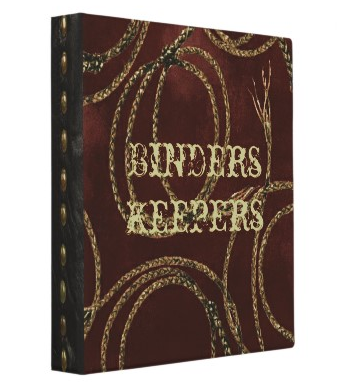
Mitt’s binder comment exposes the gender gap in terms of employment, wages, and benefits. Here, the binders represent keepers, exposing the sexist values of binding and keeping women in their place, which is, of course, beneath men. Holding women back, holding women down, limits and hurts families and our nation as a whole. And we know it.
Romney, Scarborough, et al., they seem to be mistaking fact for fiction, mistaking the female fantasies of sexual submission a la Fifty Shades for real world desires to be held down economically. While these guys substitute fiction for fact, we are not confused. We see them for what they are: Liars and anti-feminist.
To commemorate 2012, how about this Western-print binder featuring rope, customized with the words “Binders Keepers”. You can fill it with all the news stories this year.
The Political Shades Of A Colorpillar
When I grabbed this Romper Room Colorpillar toy, I had vague memories of the Romper Room TV show…
But not enough, apparently. A quick look at the Wiki entry and it turns out this toy is most fitting for this political season.
First, there’s the whole problem with children’s television shows and hosts pitching product during shows. Romper Room was the first target of the newly formed watchdog group Action for Children’s Television who leveraged the power of an threat FCC threat into ceasing “host-selling”.
Then there’s the whole Romper Room abortion scandal.
In 1962, the hostess of the Phoenix franchise of Romper Room linked her own name with that of the ongoing controversies over abortion. Sherri Finkbine, known to television viewers as “Miss Sherri”, sought hospital approval for abortion on the ground that she had been taking thalidomide and believed her child would be born deformed. Finkbine made a public announcement about the dangers of thalidomide, and the hospital refused to allow an abortion, apparently because of her announcement and its own fear of publicity. Finkbine traveled to Sweden for the abortion. Upon completion, it was confirmed that the fetus had no legs and only one arm. The incident became a made-for-TV movie in 1992, A Private Matter, with Sissy Spacek as Finkbine.
I guess this really is an educational toy — if you research it, rather than play with it.
In terms of memories of the show, as I said, they are fuzzy. Not all warm and fuzzy; just not clear. Also according to Wiki:
The hostess would also serve milk and cookies to the children, with prayer offered before eating. The famous Romper Room prayer went “God is great, God is good. Let us thank him for our food. Amen.”
Now that’s the prayer I remember saying. But that’s really odd, because our home was not a praying home. Perhaps this praying business is why I don’t recall much of the show… Perhaps when my folks found out prayer and indoctrination was part of the program, they switched the set off. That is something I will have to ask them.
50 Shades Of Humiliating
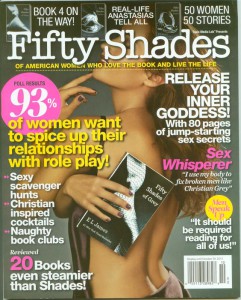
When I spotted the cover of the Fifty Shades magazine leering at me from it’s in-your-face product positioning in the check-out lane at a local grocery store, I immediately broke out into a grin of disbelief. Here? In Fargo, North Dakota?! How utterly fabulous!
In a world where human sexuality is taboo — and women’s rights to have it is steadily shrinking, I was so giddy with the mere idea of the magazine sitting on display so blatantly, so defiantly, that I pounced on a copy. And unable to contain myself, I dared to speak aloud.
“I bet you’ve seen a lot of these leaving — and with old ladies like me,” I said to both the male cashier and the bag boy precisely at the moment the cashier was scanning the publication.
The cashier managed to avoid eye contact and comment via hyper-focus on his check-out duties. The bag boy, caught off guard, looked to see what I was speaking about as it was handed to him and he awkwardly, loudly, replied, “Umm, we must have just got these in; I haven’t seen them before now.” Followed by profuse blushing as his brain caught up with what his eyes were reading.
It was rather anticlimactic.
Even though I’m not sure what I was expecting or hoping for.
But if buying this magazine was anticlimactic, it was a major disappointment to read it.
Filled with pages of uncredited “articles” which were so bland it would make the much disliked and even hated Cosmo seem intelligent, Fifty Shades just left me feeling sad, yet again, about the sad state of magazines for women.
In Underwary, feminist platitudes serve to bolster mocking men — while focusing primarily on male pleasure: “It’s your body,” “Men don’t understand lingerie,” “He will blow it,” “Instead of letting him navigate the world of satin and lace all alone, surprise him and say you’re going shopping together. He’ll think you look great, you’ll feel great, and everyone will benefit. (But mostly him.)”
Oh, and don’t forget to exercise and diet too.
Because it’s important for women to focus on their appearance even during fantasies.
*heavy sigh*
Now, I’ve never ready any of the 50 Shades books, so as an ethical reviewer I can’t say anything about how “true” the magazine is to the “steamy series”. But that won’t stop me from having an opinion — an educated opinion — regarding the reaction to the books.
As a woman, I’ve not only taken a rather long road to my own personal sexual discoveries and satisfaction, but along the way I’ve uncovered and pondered our historical and cultural cues regarding sexuality — these being, largely, the reasons it was such a long road. And as a collector, I’ve been documenting this as a part of women’s history as well. The short story is that this whole Fifty Shades thing is not new. Not in terms of books; not in terms of shock and backlash either. We have a lot of dumb rules and taboos about gender and sex (NWS).
For those reasons, this Fifty Shades magazine will not be tossed out but rather saved as part of my collection. As will my scarlet letter “A”. (I got mine! Did you get yours?) The difference, obviously, is which one I believe in, like, admire…
The biggest question then is, do I leave some sort of notes about that so that my kids or future people know why I saved these things, what kind of person I was?
Vintage Space Age Panties
A vintage gag gift for women, still in the original box which reads:
“Out of this World”
Space Age Panties
for Mi LadyFench Delight
Daring!
Unusual!
Comfortable!
Inside the box, a simple typed note:
End-orsed by Leading Astronuts for the GAL who thinks HERS is out of this world.
And a pair of sheer lime green chiffon nylon panties with black lace trim — crotchless, of course.
Ever notice how risque men’s gag gifts (NWS) are usually, well, rather useless; but those for women are to be worn. This makes the joke literally on her, with him getting the last laugh.
Of course, men are willing to wear risque and even tasteless gag gifts (NWS), so I guess it’s just harder to make a man gag.
Play Vintage Halloween Fortune Games!
Get a digital copy of this vintage Whirl-O Halloween Fortune and Stunt Game Wheel for your Halloween party! From AlteredArtifacts.


